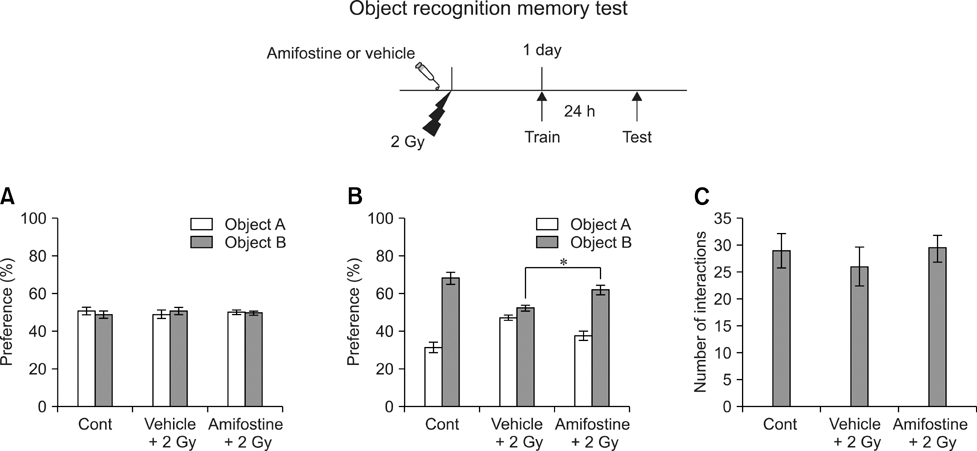J Vet Sci.
2010 Mar;11(1):81-83. 10.4142/jvs.2010.11.1.81.
Amifostine ameliorates recognition memory defect in acute radiation syndrome caused by relatively low-dose of gamma radiation
- Affiliations
-
- 1Korea Institute of Radiological and Medical Science, Seoul 139-240, Korea.
- 2College of Veterinary Medicine and Animal Medical Institute, Chonnam National University, Gwangju 500-757, Korea. moonc@chonnam.ac.kr
- 3Advanced Radiation Technology Institute, KAERI, Jeonbuk 580-185, Korea.
- 4College of Veterinary Medicine Jeju National University, Jeju 690-756, Korea.
- KMID: 1106161
- DOI: http://doi.org/10.4142/jvs.2010.11.1.81
Abstract
- This study examined whether amifostine (WR-2721) could attenuate memory impairment and suppress hippocampal neurogenesis in adult mice with the relatively low-dose exposure of acute radiation syndrome (ARS). These were assessed using object recognition memory test, the terminal deoxynucleotidyl transferase-mediated dUTP nick end-labeling assay, and immunohistochemical markers of neurogenesis [Ki-67 and doublecortin (DCX)]. Amifostine treatment (214 mg/kg, i.p.) prior to irradiation significantly attenuated the recognition memory defect in ARS, and markedly blocked the apoptotic death and decrease of Ki-67- and DCX-positive cells in ARS. Therefore, amifostine may attenuate recognition memory defect in a relatively low-dose exposure of ARS in adult mice, possibly by inhibiting a detrimental effect of irradiation on hippocampal neurogenesis.
MeSH Terms
-
Acute Radiation Syndrome/drug therapy/*immunology/psychology
Amifostine/*pharmacology/therapeutic use
Animals
Apoptosis/immunology
Gamma Rays/*adverse effects
Hippocampus/immunology
Immunohistochemistry
In Situ Nick-End Labeling
Male
Memory/*radiation effects
Mice
Mice, Inbred ICR
Neurogenesis/immunology
Radiation-Protective Agents/*pharmacology/therapeutic use
Figure
Reference
-
1. Dubois A, Walker RI. Prospects for management of gastrointestinal injury associated with the acute radiation syndrome. Gastroenterology. 1988. 95:500–507.
Article2. Guelman LR, Cabana JI, del Luján Pagotto RM, Zieher LM. Ionizing radiation-induced damage on developing cerebellar granule cells cultures can be prevented by an early amifostine post-treatment. Int J Dev Neurosci. 2005. 23:1–7.
Article3. Guelman LR, Zorrilla Zubilete MA, Rios H, Zieher LM. WR-2721 (amifostine, ethyl®) prevents motor and morphological changes induced by neonatal X-irradiation. Neurochem Int. 2003. 42:385–391.
Article4. Kempermann G, Kuhn HG, Gage FH. Genetic influence on neurogenesis in the dentate gyrus of adult mice. Proc Natl Acad Sci USA. 1997. 94:10409–10414.5. Kim JS, Lee HJ, Kim JC, Kang SS, Bae CS, Shin T, Jin JK, Kim SH, Wang H, Moon C. Transient impairment of hippocampus-dependent learning and memory in relatively low-dose of acute radiation syndrome is associated with inhibition of hippocampal neurogenesis. J Radiat Res (Tokyo). 2008. 49:517–526.
Article6. Kuhn HG, Dickinson-Anson H, Gage FH. Neurogenesis in the dentate gyrus of the adult rat: age-related decrease of neuronal progenitor proliferation. J Neurosci. 1996. 16:2027–2033.
Article7. McDonough JH, Mele PC, Franz CG. Comparison of behavioral and radioprotective effects of WR-2721 and WR-3689. Pharmacol Biochem Behav. 1992. 42:233–243.
Article8. Peissner W, Kocher M, Treuer H, Gillardon F. Ionizing radiation-induced apoptosis of proliferating stem cells in the dentate gyrus of the adult rat hippocampus. Brain Res Mol Brain Res. 1999. 71:61–68.
Article9. Purdie JW, Inhaber ER, Schneider H, Labelle JL. Interaction of cultured mammalian cells with WR-2721 and its thiol, WR-1065: implications for mechanisms of radioprotection. Int J Radiat Biol Relat Stud Phys Chem Med. 1983. 43:517–527.
Article10. Srinivasan M, Sudheer AR, Pillai KR, Kumar PR, Sudhakaran PR, Menon VP. Influence of ferulic acid on gamma-radiation induced DNA damage, lipid peroxidation and antioxidant status in primary culture of isolated rat hepatocytes. Toxicology. 2006. 228:249–258.
Article11. Yuhas JM, Spellman JM, Culo F. The role of WR-2721 in radiotherapy and/or chemotherapy. Cancer Clin Trials. 1980. 3:211–216.
- Full Text Links
- Actions
-
Cited
- CITED
-
- Close
- Share
- Similar articles
-
- The Combined Effects of Amifostine and Interleukin 1 Beta (IL-1beta) on Radiation-induced Gastrointestinal and Hematopoietic Injury
- Green tea ameliorates recognition memory defects in acute radiation syndrome caused by gamma irradiation
- Low-dose Gamma-irradiation Effect on Early Stage Development and Lifespan in Various Strains of Drosophila melanogaster
- Cytotoxicity of gamma-ray in rat immature hippocampal neurons
- Radioprotective role of amifostine on osteointegration of titanium implants in the tibia of rats



